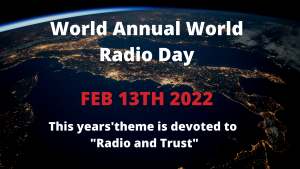
This Annual event dedicated to radio was created by *UNESCO in 2011.
*UNESCO stands for The United Nations Educational, Scientific and Cultural Organisation which is a specialised agency of the United Nations aimed at promoting world peace and security through international cooperation in education, arts, sciences, and culture.
The first-ever world radio day commenced in 2011 on the anniversary of the founding of United Nations Radio.
This year 2022 theme is devoted “Radio and Trust”
Reporting of radio use around the world indicates that radio continues to be one of the most trusted and used media in the world. In more recent times, even during the most connected era, the isolating nature of word pandemics, natural disasters, and weather events, radio has continued to be a trusted source of communications, not only to those in more isolated regions but also when power is out and connectivity is severed.
Radio is a powerful medium for celebrating humanity in all its diversity and constitutes a platform for democratic discourse. At the global level, radio remains the most widely consumed medium. This unique ability to reach out to the widest audience means radio can shape a society and serves as an arena for all voices to speak out, be represented, and heard.
Radio stations serve diverse communities, offering a wide variety of programs, viewpoints, and content, and reflect the diversity of audiences in their organizations and operations.
What will you do to celebrate World Radio Day? Turn on your radio, tune the shortwave bands and see what countries you can hear. There is always something happening on the shortwave bands, someone to listen to and learn from.
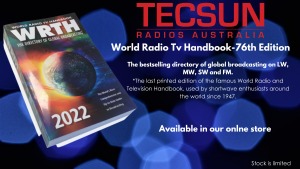
Tecsun Radios Australia is proud to offer you the opportunity to own this piece of history in the making!
This is 76th edition is the last printed edition of the famous World Radio and Television Handbook, used by shortwave enthusiasts around the world since 1947.
Do not miss the opportunity to acquire the last printed version of the valuable radio resource, often promoted as the most comprehensive guide to broadcasting on the planet.
A must-have for all short wave enthusiasts, This regularly updated handbook is the culmination of an international network of contributors to provide the most up-to-date information on mediumwave, shortwave, and FM broadcasts and broadcasters available in any publication.
This 670-page book contains the includes articles on the further development of HF transmitters, the history of Radio, technical monitoring at VOA, the history of KTWR on Guam as well as the following.
An A-Z country by the country directory of national radio stations with SW, MW, and FM frequencies and contact details, websites and more.
International Radio – full details of the broadcasters and their winter (B20) shortwave frequency schedules, with an expanded Clandestine section.
Frequency Lists – MW by frequency within the region, SW by frequency including DRM broadcasts.
Technical Articles
Reviews of the latest receivers & equipment, including many Tecsun models.
Alphabetical listing of TV broadcasters by country
Colour Maps showing SW transmitter sites
Reference pages including domestic and International Shortwave transmitters, DX Clubs, Standard Time & Frequency transmissions, Internet resources etc
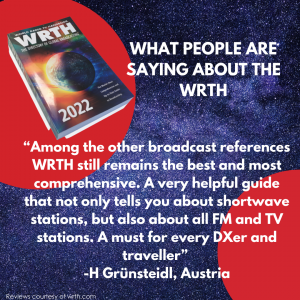
Get your copy here
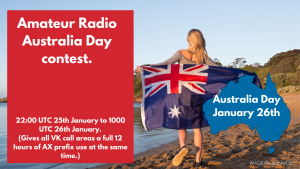
Got plans for Australia Day? You may want to change them and test your shortwave operating skills!
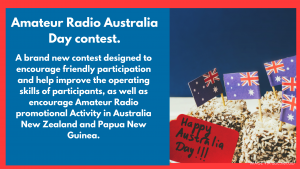
This Australia Day why not enter the Amateur Radio Australia Day contest?
This is the first time this contest has been held to promote community participation and to improve operating skills and will no doubt become an institution every Australia Day!
The aim of the contest: Amateurs in Australia, New Zealand or Papua New Guinea and their external territories, will endeavor to contact other stations in the region. Points are awarded for valid contacts between VK, ZL, and P2 stations based on the number of contacts made.
HF SSB Voice transmissions should be within:
1843-1875, 3535-3570 and 3600-3700, 7080-7300, 14112-14300, 21150-21450, 28300-29100KHz
Who can enter? Only licensed amateur radio operators can enter, however shortwave listeners can listen to contestants making contacts.
A contest like this, where there are likely to be many amateurs on air, is a good opportunity for shortwave listeners to improve their antenna systems.
What equipment would be suitable to enter? The Xiegu G-90 and the HF Dipole antenna would be a highly suitable combination to both receive and transmit.
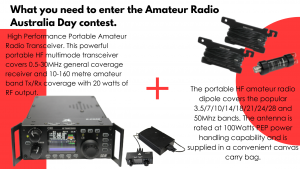
How can you listen?
Listeners could use PL-330, PL365 and PL368, PL-880, PL-990x or H501x receivers.
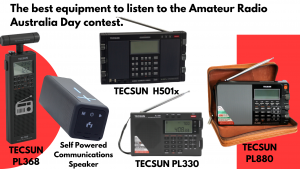
Want the best sound possible when listening to the contest or in fact shortwave radio in general?? We highly recommend listening on your TRA Self-powered Communication Speaker which is ideal for use in amateur radio contests as it makes listening to weak stations much easier!
For more information including the contest rules and how to log your results read the detailed events page on the Wireless Institute of Australia HERE


